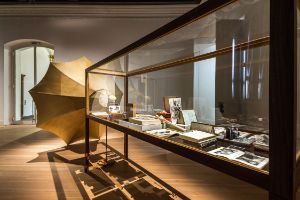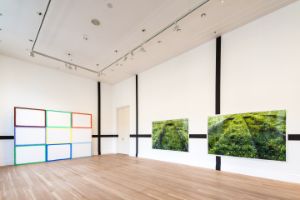Tabita Rezaire, Farmers’ Wisdom, 2022. Installation view, YOYI! Care, Repair, Heal, 2022/23 © Gropius Bau, photo: Laura Fiorio
Interview with Stephanie Rosenthal for the Museumsjournal
By Anne Haun-Efremides
Concepts like healing and caring can be found everywhere – and not just since the start of the pandemic or because of the war in Ukraine. Why does this subject seem so pressing in the art world to you?
Artistic engagement with this topic is not something new. Art has always been close to life. One of the approaches pursued by the exhibition YOYI! Care, Repair, Heal aims to make clear that artists have an impact on the social fabric and bring about social change not only through their art, but also their actions. This was already a major concern for Allan Kaprow, who invented happenings. Artists are visionaries. They are instrumental in rethinking the way we relate to nature and each other. This inevitably brings questions of care and health to the fore.
Why is that?
One of the curator’s main tasks is caring – for the artists and the audience. This is where the imperative need for communication comes into play. It is a concern that is only starting to become more important in Germany, but it has already been established for a long time in other countries. We have initiated a project called Resonance Room in collaboration with the London-based Wellcome Trust. It is about mental health and how it relates to culture. It was in this context that our programme Ámà was developed last November.
Ámà was a four-day event on the subjects of “caring, repairing and healing”, including lectures on meditation, speed dating sessions and workshops. It enabled you could to consider the question of what care feels like in a museum setting. What answers did you find?
Ámà was deliberately broad in its scope. As a preparatory stage for the exhibition, it allowed us to explore the interdependencies and entanglements of systems and structures, such as the relationship between institutions and people, and historically-established barriers that are perpetuated through language, architecture and so much more. Efforts are already being made in many places to find ways of caring and repairing in the broadest sense of these terms, while looking at the histories behind them – which are often contradictory. The obvious question here is what is missing, since everything is interconnected.

YOYI! Care, Repair, Heal, Brook Andrew: GABAN | Anatomy of a Body Record: Beyond Tasmania, Installation view, Gropius Bau (2022)
photo: Laura Fiorio
Culture and art in particular are the first victims of authoritarian systems. Isn’t the aspiration to heal through art a little naïve?
To answer with another question: who formulates this claim to healing and what does it mean? This need for healing is problematic for many artistic practices. They show that healing is not possible. Instead, we are approaching this concept by looking at the very relationships that we in the so-called Global North should be building and managing differently. I am very influenced by Donna Haraway’s book Staying with the Trouble: Making Kin in the Chthulucene and her idea of kinship. In the context of social organisation, kinship alludes to relationships in the present, past and future, thus linking human and more-than-human communities. In my opinion, exhibitions are a kind of kinship. In the best case, we can find through art a kind of “common ground” between different disciplines and fields, something that we perhaps would not achieve otherwise.
Do museums have a new social or, to be more precise, caring responsibility?
The starting point for this exhibition was the question: what does it actually mean to welcome people and extend this hospitality? Museums also have to be places for community. That being said, we know that in a huge bureaucratic institution like the Gropius Bau, caring is primarily a lovely idea. But in the end, you remain trapped in structures that make it difficult to actually put it into practice.
Your artist line-up also includes healers and shamans, for whom art-making is secondary. Could you introduce us to some of your artistic positions?
I started this project with Kader Attia. I actually wanted us to work on a solo exhibition. The concept of repairing is crucial for Attia, as well as making scars visible and dealing with trauma. As the exhibition’s co-curator, he is presenting André Eugène and Reginald Sénatus (Redji), two Haitian artists of Atis Rezistans (Resistance Artists) – a collective from Port-au-Prince that often works with recycled materials as a form of repair.
I invited Brook Andrew because he represents the Indigenous community on many levels. He is an Aboriginal artist and has also worked as a consultant for major collections for decades. For our exhibition, he has written a critical but still very funny play that addresses the question of how objects “feel” in a museum. It is about, for instance, the transformation of an object’s aura when it is torn out of its context and brought into the museum, as well as the question of who has the right to decide which objects belong in the museum or not.

YOYI! Care, Repair, Heal, Andrea Büttner: Grid | Untitled (Painted Ceiling) | Former plant beds from the plantation and “herb gardens,” used by the Nazis for biodynamic agricultural research, at the Dachau Concentration Camp | Karmel Dachau, Installation view, Gropius Bau (2022)
photo: Laura Fiorio, © Andrea Büttner / VG Bild-Kunst, Bonn 2022
Brook Andrew is also a member of your curatorial team.
In this capacity, he has also invited other Indigenous artists, such as Betty Muffler and Maringka Burton, who are both traditional healers. Their works actually deal with the process of healing through painting, specifically the healing of one’s community. Spirituality definitely takes centre stage in their practices.
Why are you curating this exhibition collectively?
We decided to work as a curatorial team because it was important to us to look at this subject from a wide variety of angles, and that means not only through a Western lens. This is only feasible if you actually represent different perspectives accordingly.
What is the driving force behind the other artistic approaches in this exhibition?
An artist like Grace Ndiritu would probably like to do a workshop on “healing museums”. That’s admittedly a bit naïve, but I still think it’s important to show these points of view, because even a particular stance can make a difference.
For most artists, however, the focus is on the impossibility of healing, which is ultimately exhausted in making the problem visible. Take Andrea Büttner, for example, who has a large space in the exhibition. She focuses on German history and the process of coming to terms with it, showing photos of the herb garden in the Dachau concentration camp, where anthroposophical approaches and healing plants were used. Her position is rather against healing; it is impossible to break out of the structures and traumas of history.
Will you be showing older artistic practices in this exhibition?
Yes, occasionally. Lygia Clark, for example, is an artist from the 1960s. She was a therapist as well as an artist and used her sculptures in her therapeutic work. The oldest artistic figure we have is Artemisia Gentileschi. She is considered to be the most outstanding painter of the 17th century. Gentileschi’s paintings primarily depict violent scenes combined with heroic female figures, something that is often associated with her biography. As a young woman, she was raped by her teacher. Her paintings are read in art history as taking an activist stance.
Activism as a means of self-healing?
Painter Paula Rego is a concrete example of how art can serve as a means to mitigate historical injustice or grievances, or at least make them visible. She was also an important figure to us because of her activist approach, as she spoke out against the abortion law in Portugal in the late 1990s and addressed this in her paintings and etchings. Ultimately, she contributed to liberalizing the legislation.